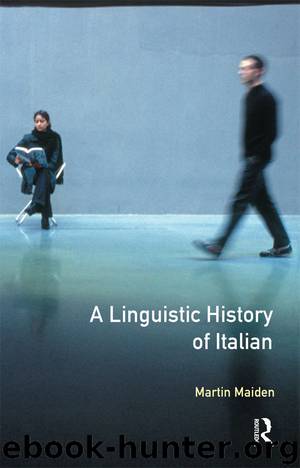Linguistic History of Italian, A (Longman Linguistics Library) by Martin Maiden

Author:Martin Maiden
Language: eng
Format: mobi
ISBN: 9781317899266
Publisher: Taylor and Francis
Published: 2014-06-10T22:00:00+00:00
8.8.3 The ‘progressive’ structures stare/andare/venire + gerund
In the earliest Italo-Romance attestation of the construction sta facendo ‘she is doing’, stare has all the attributes of an autonomous lexical verb, meaning ‘to stand’ or ‘remain’. It can occur in all tense forms and in the imperative, and is readily separable from the gerund: e.g., Aretino sono stato un poco pensando meco ‘I stood/was a while thinking to myself; Brusoni stette buona pezza il cavaliere pensando su questa lettera ‘the knight stood a good while thinking about this letter’ (cf. Durante (1981: 180)). This complex-verb structure is still rare in northern Italian dialects,47 but very frequent in the south and centre (Rohlfs (1969: 108f.)). It begins to gain ground in Tuscan from the sixteenth century, but its basic meaning remains, until relatively recently, stative, rather than progressive (cf. Durante (1981: 180; 268f.); Bertinetto (1986: 137 n7)). The ‘immobility’ inherent in the lexical verb stare (meaning ‘stand’, ‘remain in place’), debarred combination of stare with dynamic or ‘transformative’ verbs (e.g., those expressing motion or change of state), so that sto leggendo ‘I'm reading’ has always been admitted, but not sto andando ‘I'm going’ nor sto diventando ‘I'm becoming’. It is only from the middle of the twentieth century, and possibly under the influence of English be … ing constructions (Durante (1981: 269)), that this structure begins to appear regularly with verbs expressing the progressive development or unfolding of any action: sta andando ‘she's going’; sta venendo ‘she's coming’, etc. According to Durante, even at the beginning of the 1980s the type sta piovendo ‘it's raining’ was still little used by the older generation. A detailed account of the expanding use of the stare + gerund structure is given in Squartini (1990).
In the structure venire ‘to come’ or andare ‘to go’ + gerund, the auxiliary verbs remain close to their lexical meaning. Venire in this construction indicates movement towards some goal, hence ‘gradual achievement of an action’, (cf. Lepschy and Lepschy (1981: 135f.)), just as the lexical verb indicates movement towards a goal located with or near the speaker; andare expresses movement or progression, without any necessary aim. Both auxiliaries retain the full morphological paradigm of the corresponding lexical verbs: è andato cercando ‘he has gone looking’; è venuto costruendosi ‘it has been getting built’, etc. The auxiliaries are also separable from the gerund, e.g., va ogni due o tre giorni cercando funghi ‘she goes every two or three days looking for mushrooms’. The structure with andare is already established in the seventeenth century (e.g., Galileo va continuamente scuoprendo ‘he's continually discovering’), but Squartini observes that in the first half of the nineteenth century, it is the verb forms with andare (and the much less frequent venire) which serve to express the gradual, incremental progression of an event or action, while stare + gerund indicates principally imperfectivity and durativity. Yet over the past two hundred years, stare has tended to take over the functions originally expressed by andare in combination with the gerund, with a corresponding major decline in the frequency of the latter.
Download
This site does not store any files on its server. We only index and link to content provided by other sites. Please contact the content providers to delete copyright contents if any and email us, we'll remove relevant links or contents immediately.
Cecilia; Or, Memoirs of an Heiress — Volume 1 by Fanny Burney(32434)
Cecilia; Or, Memoirs of an Heiress — Volume 2 by Fanny Burney(31869)
Cecilia; Or, Memoirs of an Heiress — Volume 3 by Fanny Burney(31852)
The Lost Art of Listening by Michael P. Nichols(7403)
Asking the Right Questions: A Guide to Critical Thinking by M. Neil Browne & Stuart M. Keeley(5632)
We Need to Talk by Celeste Headlee(5542)
On Writing A Memoir of the Craft by Stephen King(4863)
Dialogue by Robert McKee(4321)
Pre-Suasion: A Revolutionary Way to Influence and Persuade by Robert Cialdini(4144)
I Have Something to Say: Mastering the Art of Public Speaking in an Age of Disconnection by John Bowe(3839)
Elements of Style 2017 by Richard De A'Morelli(3306)
The Book of Human Emotions by Tiffany Watt Smith(3237)
Fluent Forever: How to Learn Any Language Fast and Never Forget It by Gabriel Wyner(3025)
Name Book, The: Over 10,000 Names--Their Meanings, Origins, and Spiritual Significance by Astoria Dorothy(2938)
Good Humor, Bad Taste: A Sociology of the Joke by Kuipers Giselinde(2903)
Why I Write by George Orwell(2874)
The Art Of Deception by Kevin Mitnick(2735)
The Grammaring Guide to English Grammar with Exercises by Péter Simon(2706)
Ancient Worlds by Michael Scott(2622)
